-
PostgreSQL Tutorial
PostgreSQL Database
PostgreSQL Table
- postgresql-create-table
- postgresql-drop-table
- postgresql-show-table
- postgresql-describe-table
- postgresql-alter-table
- postgresql-add-column
- postgresql-drop-column
- change-column-type
- postgresql-rename-column
- postgresql-truncate-table
- postgresql-temporary-table
- postgresql-column-alias
- postgresql-sequence
- identity-column
- postgresql-upsert
- postgresql-subquery
Data Types
- postgresql-datatypes
- postgresql-numeric
- postgresql-character
- postgresql-text
- postgresql-varchar
- postgresql-boolean
- postgresql-integer
- postgresql-smalllint
- postgresql-bigint
- postgresql-serial
- postgresql-date
- postgresql-time
- postgresql-timestamp
- postgresql-interval
- postgresql-uuid
- postgresql-json
- postgresql-hstore
- postgresql-array
- user-defined-data-type
PostgreSQL Schema
PostgreSQL Queries
PostgreSQL Clause
- postgresql-where
- postgresql-order-by
- postgresql-group-by
- postgresql-having
- postgresql-distinct
- postgresql-limit
- postgresql-fetch
PostgreSQL Conditions
- postgresql-condition
- postgresql-and
- postgresql-or
- postgresql-and-or
- postgresql-not
- postgresql-like
- postgresql-in
- postgresql-not-in
- postgresql-between
- postgresql-exists
PostgreSQL Views
PostgreSQL Join
- postgresql-join
- postgresql-inner-join
- postgresql-left-join
- postgresql-right-join
- postgresql-full-join
- postgresql-cross-join
- postgresql-self-join
- postgresql-natural-join
PostgreSQL Trigger
PostgreSQL Indexes
- postgresql-indexes
- postgresql-create-index
- postgresql-drop-index
- postgresql-list-indexes
- postgresql-unique-index
- postgresql-index-on-expression
- postgresql-partial-index
- postgresql-reindex
- postgresql-multi-column-indexes
Database Constraints
- postgresql-constraints
- postgresql-primary-key
- postgresql-foreign-key
- unique-constraint
- check-constraint
- not-null-constraint
PostgreSQL Advance
- postgresql-functions
- postgresql-alias
- postgresql-date-time
- psql-commands
- postgresql-union
- postgresql-intersect
- postgresql-except
Differences
- mongodb-vs-postgresql
- postgresql-vs-sql-server
- postgresql-vs-mariadb
- postgresql-vs-oracle
- postgresql-vs-sqlite
Interview
PostgreSQL ArrayIn this section, we are going to understand the working of the PostgreSQL Array data type, examples of the array data type, and some accessible Array functions like unnest(), ANY(), which help us to handle array values more efficiently. And we also see the example of using the array elements within the WHERE clause. What is PostgreSQL array Data Type?In PostgreSQL, the Array data type has played an important role. As we know that, each data type has its companion array type, such as a character has character[] array type, integer has an integer[] array type, etc. PostgreSQL allows us to specify a column as an array of any valid data type, which involves user-defined data type, enumerated data type, and built-in datatype. Note: PostgreSQL generates a consistent array type in the background for us to describe our data type.Syntax of PostgreSQL Array data typeThe syntax of the PostgreSQL Array data type is as follows: Example of PostgreSQL Array data typeLet us see sample examples to understand how the PostgreSQL Array data type works. We are creating one new table as person_details with the CREATE command's help and inserting some values using the INSERT command. Creating a PostgreSQL Array tableThe person_details table contains the various columns such as id, person_name, and Mobile_numbers, and for the Mobile_number column, we use the one-dimensional array that contains several Mobile numbers that a person may have. Output On executing the above command, we will get the following message window, which displays that the person_details table has been created successfully into the Organization database. 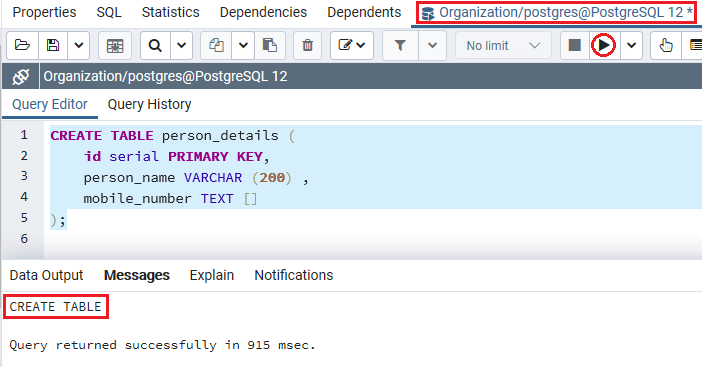 Inserting PostgreSQL array valuesWhen the person_details table is created successfully, we will insert some values into it with the INSERT command's help. Output After implementing the above command, we will get the following message window, which displays that the values have been inserted successfully into the person_details table. 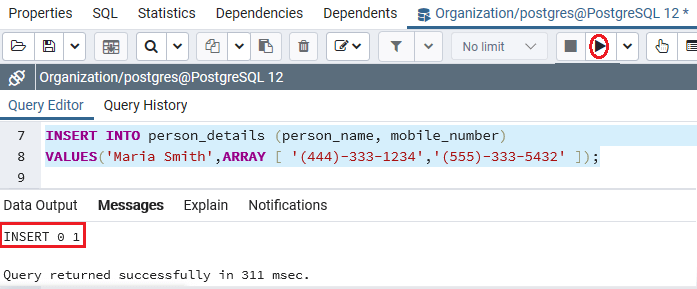 In the above insert command, we have used the ARRAY constructor to create an array and add it into the Person_details table. And we can also use curly braces {} instead of using square brackets [] as we can see in the below command: Output We will get the following message window after executing the above command, which displays that the three values have been inserted successfully into the person_details table. 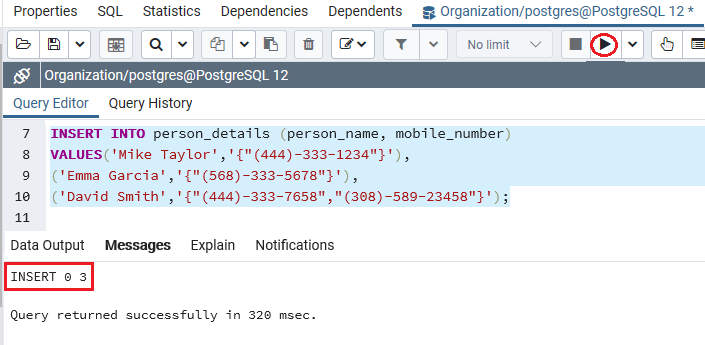 Note: As we can see in the above command, when we are using the curly braces{}, we have used the single quotes ' ' to enclose the array, and the double quotes " " for enclosing text array items.Selecting PostgreSQL Array data valuesAfter creating and inserting the person_details table's values, we will use the SELECT command to return all rows of the person_details table: Output After successfully implementing the above command, we will get the below output, which displays all the data present in the person_details table: 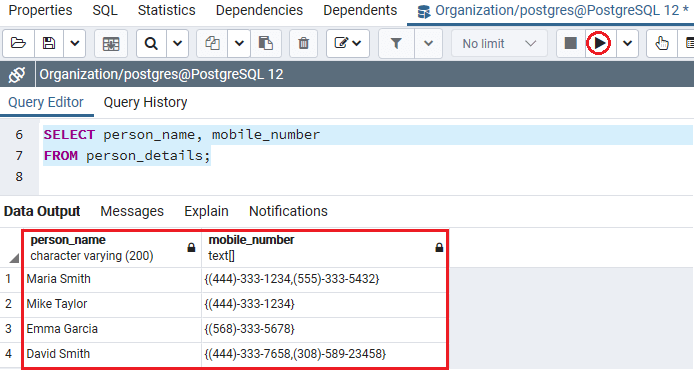 By default, if we access array elements with the help of subscript inside square brackets [], PostgreSQL uses one-based numbering for array elements, which implies that the first array element begins with number 1. Let's assume that if we need to return the person's name and the first mobile_number, as we can see in the below command: Output On executing the above command, we will get the below result, which displays the first mobile number of a person from the person_details table. 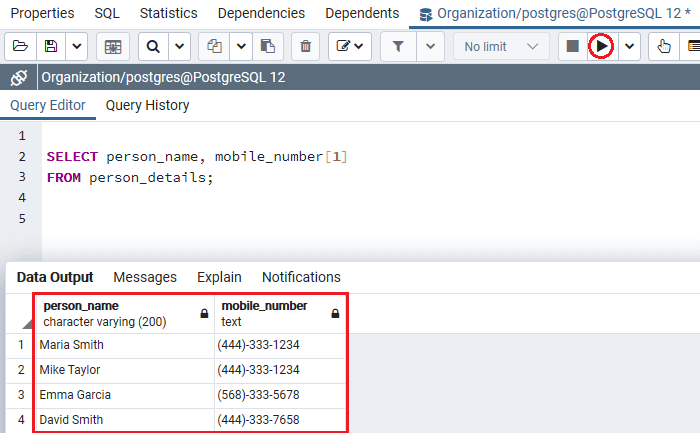 To find PostgreSQL array elements using where clauseTo filter the rows, we can use the array element in the WHERE clause as the condition. In the following example, we will use the below command to identify those people who has the mobile_number (308)-589-23458 as the second mobile number: Output After successfully executing the above command, we will get the following output, which displays that person_name with more than two mobile_numbers. 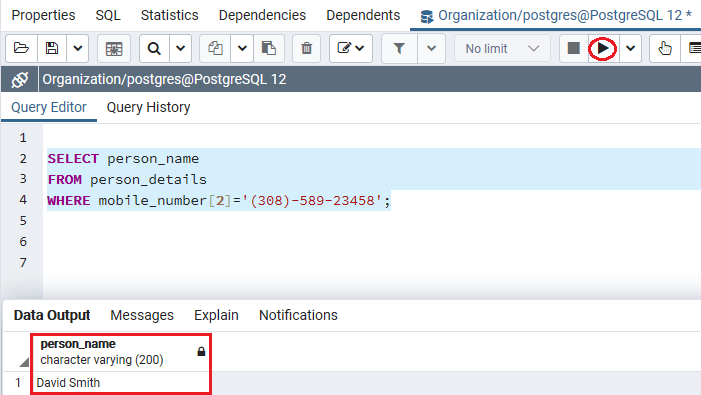 Changing PostgreSQL arrayPostgreSQL provides us to update all the elements of whole array or the array. The below command is used to update the second phone number of David smith. Output After executing the above command, we will get the below message window, which displays that the particular values have been updated successfully. 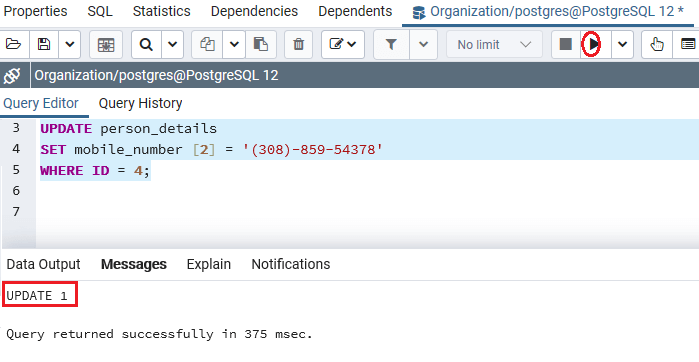 To updates an array as a whole, we can use the following command: Output After executing the above command, we will get the following message window, which represents the array as a whole: 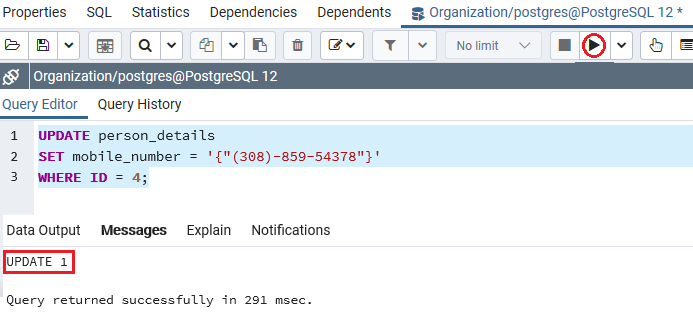 After that, we will use the below command; we will check the updated value with the help of the SELECT command: Output After successfully implementing the above command, we will get the following output, which displays the specified updated value. 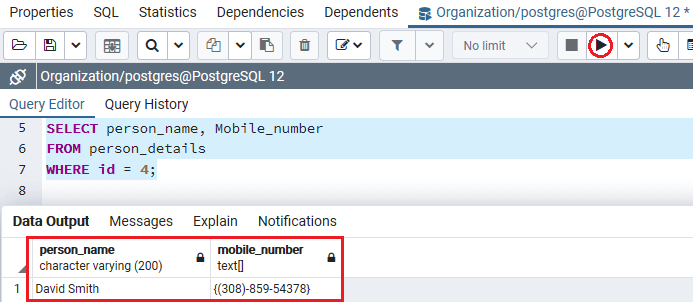 Expand PostgreSQL Arrays data typeTo expand an array to a list of rows, PostgreSQL provides the unnest() function. Let us see an example to understand how we can expand the array using the unnest() function: In the following example, the below command expands all mobile numbers of the mobile_number array. Output We will get the following output on executing the above command, which displays the expanded array to a list of rows. 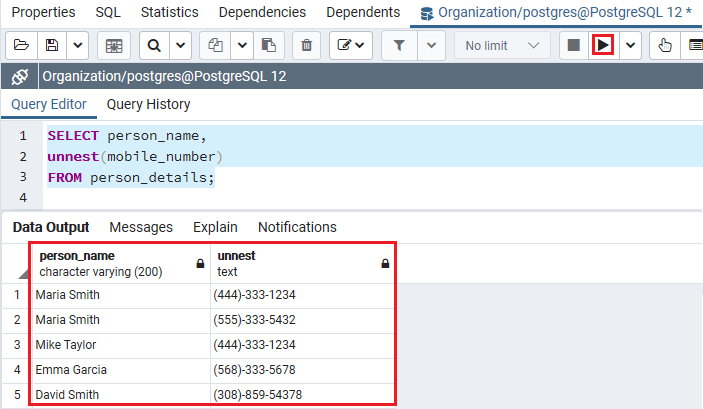 Search in PostgreSQL ArrayWe can use the ANY() function if we want to identify who has the following mobile_number (555)-333-5432 irrespective of the position for the mobile_number array as shown in the below command: Output After executing the above command, we will get the following result: 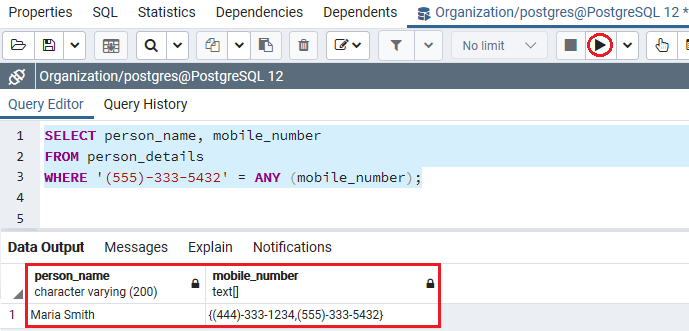 OverviewIn the PostgreSQL array data type section, we have learned the following topics:
Next TopicPostgreSQL User-Defined data type
|